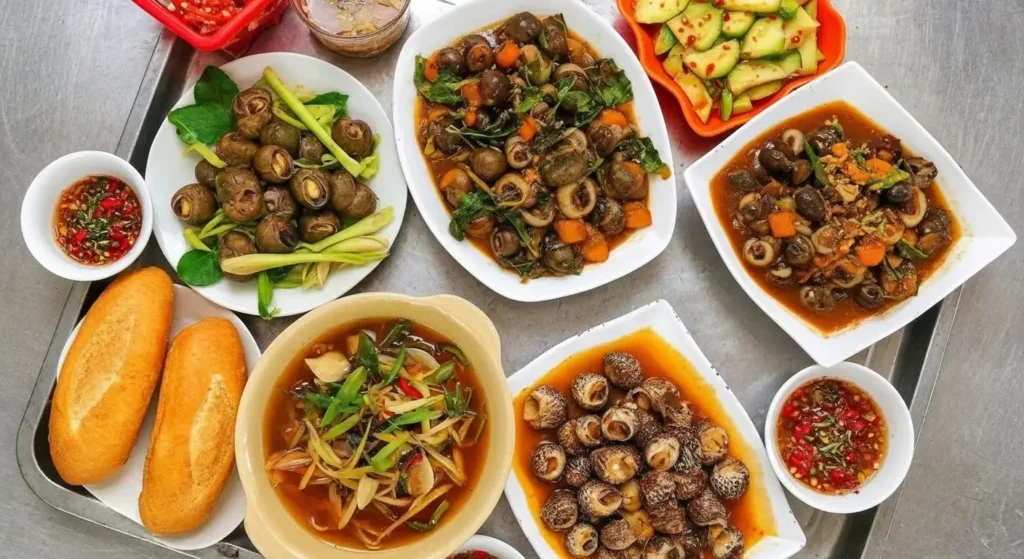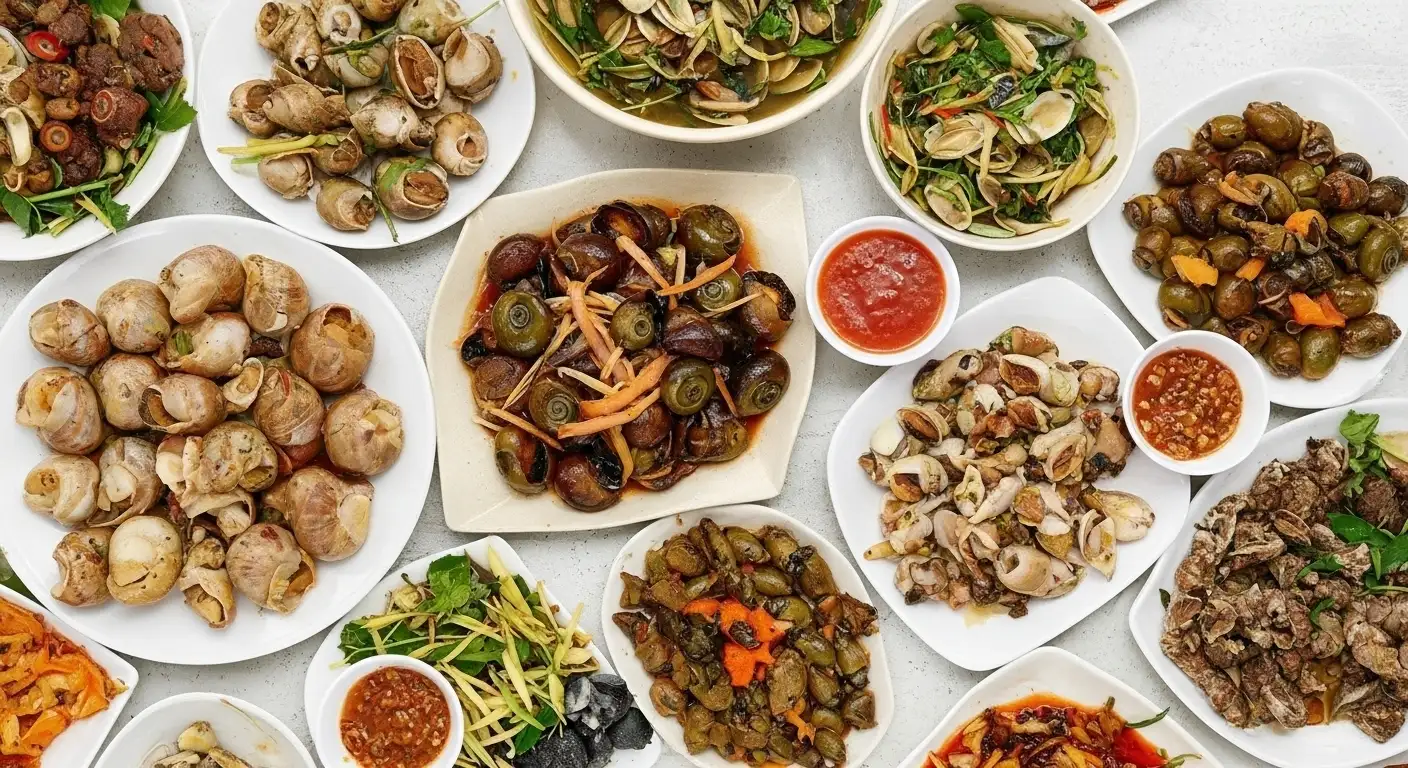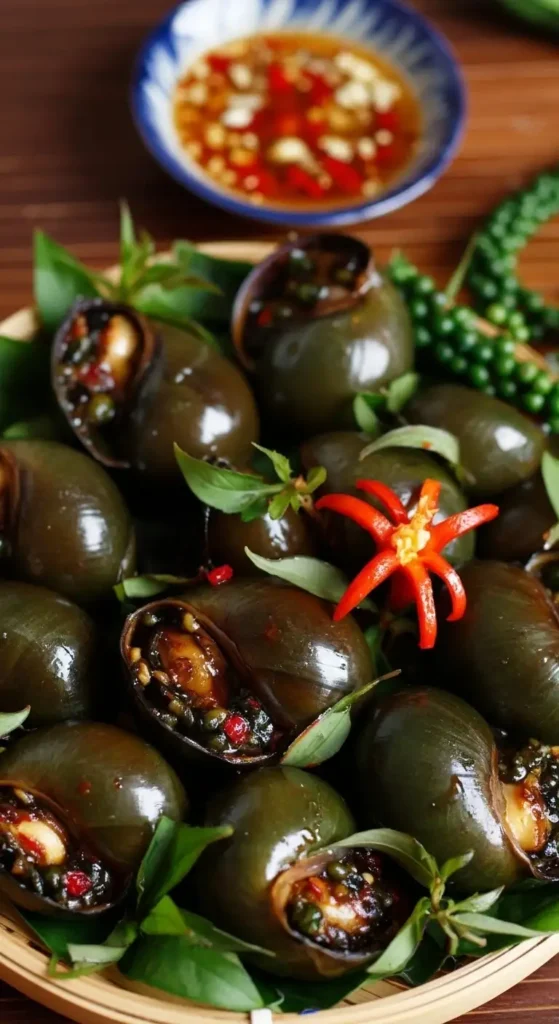Ốc (pronounced roughly Ock) is not just a food item in Vietnam; it is an entire, vibrant social eating culture. While the word Ốc literally means “snail,” in the context of Vietnamese street food, it refers to a whole category of snails, sea snails, clams, cockles, and other small shellfish, which are prepared in dozens of different ways and enjoyed in bustling, informal street-side eateries called Quán Ốc.
This culinary pastime is central to Vietnam’s nhậu (social dining/drinking) culture, focusing on sharing small, flavorful, highly seasoned plates, often accompanied by cold beer, conversation, and the lively atmosphere of the city.

Ốc: The Basics
The Ingredient: The Ốc menu is vast, featuring a wide variety of mollusks, each with a unique shape, size, and texture. Popular types include:
Ốc Hương (Sweet Snail / Spotted Babylon): Known for its fragrant, firm meat, often grilled or stir-fried with salt and chili.
Ốc Len (Mud Creeper): Long, cone-shaped snails, famous for being sautéed in a rich coconut milk sauce.
Ốc Móng Tay (Razor Clam): Elongated clams, commonly stir-fried with tamarind sauce or garlic.
Nghêu (Clams) or Sò (Cockles/Scallops): Also frequently served, often grilled with scallion oil (mỡ hành).
The Cooking Styles: The beauty of Ốc lies in the preparation. Snails are seldom eaten plain. Instead, they are vehicles for bold, aromatic flavors, utilizing quintessential Vietnamese ingredients:
Steamed (Hấp): Often with lemongrass, ginger, and chili (Ốc Hấp Sả Ớt).
Stir-fried (Xào): With tamarind, garlic, basil, or the famous coconut milk (Ốc Len Xào Dừa).
Grilled (Nướng): Topped with savory scallion oil and crushed peanuts (Sò Điệp Nướng Mỡ Hành).
Roasted (Rang): Dry-fried with salt and chili (Ốc Hương Rang Muối Ớt).
The Sauces (Nước Chấm): The dishes are often served with a separate dipping sauce, most commonly a zingy mixture of lime juice, salt, pepper, and chili (muối tiêu chanh) or a ginger-fish sauce concoction, adding a final burst of flavor and heat.
Types of Ốc Dishes (Preparation Styles)
The Ốc culture is defined less by the type of shell and more by the cooking method:
| Dish Name | Key Ingredient/Preparation | Flavor Profile |
|---|---|---|
| Ốc Len Xào Dừa | Mud Creeper snails stir-fried with rich coconut milk, lemongrass, and chili. | Rich, creamy, spicy, and sweet. A Southern classic. |
| Ốc Hương Rang Muối Ớt | Sweet Snails dry-roasted with chili, salt, and spices. | Dry, savory, extremely spicy, and aromatic. Excellent beer food. |
| Nghêu Hấp Sả | Clams or cockles steamed in a broth of lemongrass, ginger, and chili. | Clean, fresh, spicy, and savory. The broth is often consumed. |
| Sò Điệp Nướng Mỡ Hành | Scallops (or other large shellfish) grilled, topped with scallion oil and peanuts. | Oily, nutty, savory, and aromatic from the fresh scallions. |
| Bún Ốc | Freshwater Snail Noodle Soup (A Hanoi specialty, less about nhậu culture). | Tangy, savory, and light, with a tomato-based broth. |

How to Eat Ốc
Eating Ốc is an informal, communal ritual that involves specialized techniques depending on the dish:
For Ốc Len Xào Dừa (Coconut Snails): This is the most interactive. To extract the meat, you must suck on the hole of the shell, often making a loud slurping sound (considered normal and even complimentary). If the meat doesn’t come out, you may need to use a chopstick or small fork, or sometimes even bite off the pointed end of the shell first.
For Coil-Shaped Snails (Ốc Hương, Ốc Mỡ): Use the small, dedicated two-pronged fork or toothpick provided at the restaurant to carefully pry the meat out of the shell.
For Clams and Cockles (Nghêu, Sò): These are usually eaten directly from the shell. After pulling out the meat, dip it generously into the accompanying muối tiêu chanh (salt, pepper, lime, and chili) dipping sauce.
Embrace the Mess: Eating Ốc is inherently messy. It involves a lot of sloshing, slurping, and extracting. It’s a social activity where inhibitions are left at the door.
Regional Differences
The Ốc culture is present throughout Vietnam, but the specific ingredients, cooking styles, and flavor profiles vary significantly based on the local climate, water sources, and culinary traditions.
| Region | Snail Culture Focus | Key Dishes & Flavor Profile |
|---|---|---|
| North (Miền Bắc - Hanoi) | Freshwater focus; soup-based. Snail dishes are often integrated into main courses, not purely for nhậu. | The signature dish is Bún Ốc (Snail Vermicelli Soup), a light, sour, and savory broth (often tomato-based) served with freshwater snails. Northern dishes are generally less sweet and less oily. |
| Central (Miền Trung - Huế, Đà Nẵng) | Seafood variety; spicy & rich. Reflects Central Vietnam's location along the coast and its preference for strong, spicy flavors. | Dishes often use a wider variety of coastal shellfish and are known for their spiciness. Preparations are often savory-spicy, sometimes incorporating a richer flavor base than the North. Ốc Lễ (small, steamed sea snails) is a Hoi An specialty. |
| South (Miền Nam - Ho Chi Minh City) | Ultimate Nhậu culture; diverse and bold. A vibrant, year-round street food scene where Ốc is the star of social gatherings. | The most diverse menu with the most inventive cooking styles. Flavors lean sweet and rich, heavily utilizing ingredients like coconut milk (Ốc Len Xào Dừa), tamarind (Ốc Móng Tay Xào Me), and salted egg yolk. Portions are generous, and the atmosphere is bustling and energetic. |




